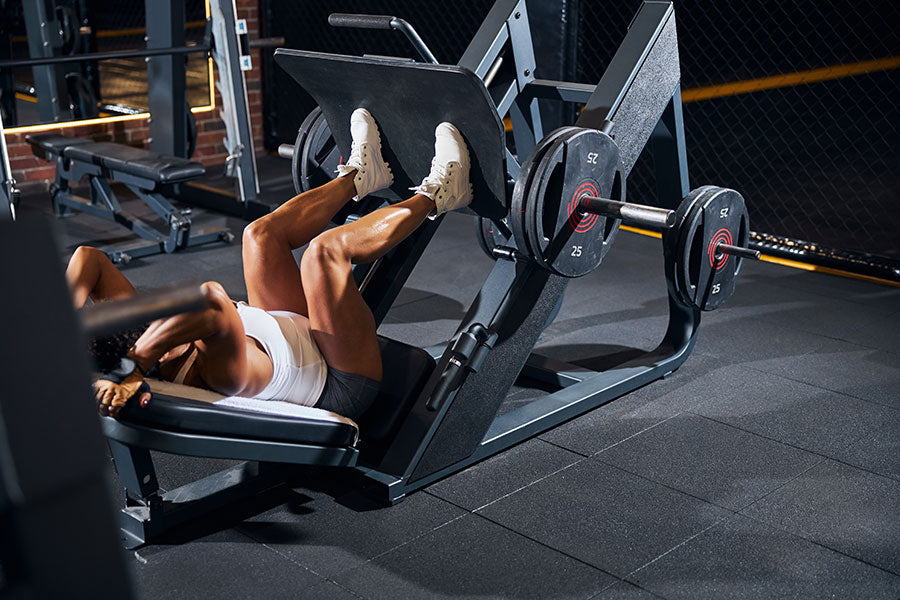The leg press is a great machine for isolating the legs. You will find it in almost any traditional gym, but you have to use it correctly, or you won't get the desired results and might even hurt yourself.
Unlike squats, you don't have to worry about balancing the weight in a leg press. Instead, you must move the weight from point A to point B.
This lets you go a little heavier than you could with a typical free-weight move. However, if you lift heavy weights with bad form, you could hurt yourself.
So, what can go wrong with this simple exercise? Let’s look at the six common mistakes people often make when doing this solid leg movement.
1. Lowering the Sled Near your Body

Leg presses are better than squats because the machine supports your back. But even though it's hard to get your thoracic spine off the pad, your lumbar spine is still at risk.
By letting the sled go down too far, lifting your butt and even the lower part of your back off the pad, you're most likely to hurt your lumbar disks, especially if you don't fully control the sled.
This mistake makes people more likely to put dangerous weight on the machine they wouldn't normally handle, and it takes a lot of pressure off the legs. To do this exercise right, you should consider turning the knees slightly outward before starting to lower the weight.
2. Doing Only Shallow Reps

The depth argument works in both directions. If you haven't heard the phrase "partial reps equal partial results," you should learn it. Anyone can put an impossible weight on a bar or machine, but if you only move it an inch or so, like I've seen many people do, you're not getting any benefit.
How far you bend depends on your goals and the muscles you want to work. If you want to focus on your quads, which are the front of your thighs, stop when your thighs and shins are at a 90-degree angle.
This puts most of the pressure on the front of your legs. Keep your legs tight and flexed when you return to the starting position, but don't lock your knees.
If you want to focus on your hamstrings and glutes—the back of your legs and butt—go 1 to 2 inches below parallel and pause at the top and bottom of the movement. This will shift the focus to different muscles while working the entire leg.
Related Article: The Best Muscle Groups to Work Out Together for Best Results
3. Not Allowing Your Heals on the Sled

Not every footplate has a lot of surface area. If you have to use a machine with a small footplate, you may be tempted to push your heels off the lower edge of the platform to work your quads. You should not do that at all.
This can actually put unnecessary strain on your quads and make it difficult to balance the weight. Instead, you should keep your heels firmly planted on the sled throughout the movement.
This will help you to engage your muscles better and produce more strength. Ultimately, it will help you avoid injuries and get the most out of your leg press workouts.
4. Letting Your Knees Cave Inward

This may happen to women more often than to men. It makes you more likely to get hurt, most of the time, by tearing your anterior cruciate ligament (ACL). This is often caused by weak hip abductors, especially the gluteus medius.
Knee valgus is a serious problem that forms lower leg deformity and occurs when the knee joint bone is angled out and away from the body's midline. This needs to be fixed right away.
Here are some of the following ways to avoid valgus when doing leg presses or squats:
- Banded moves should be made often, or you could even wear one in the press. Wrapping a band around your thighs can help send a kinesthetic cue to yourself to drive your knees out and keep the band open.
- Focus on strengthening the gluteus medius as you work on strengthening the back chain. Lunges, Romanian deadlifts, single-leg Romanians, the hip-abductor machine, and deadlifts are good exercises.
Related Article: Five At-Home Exercises for Athletes to Build Stronger Legs
5. Turning Your Feet Extremely Inward or Outward

You may know that turning your feet in or out when doing leg extensions or curls can help you focus on your quads or hamstrings. That's right, but what works well on one machine may not work well on another.
The leg extension and the leg curl are both open-chain exercises, meaning your feet are not on a solid surface. But when you do the leg press, which is a closed-chain movement where your feet stay in place, turning your feet too much can put pressure on your knees.
Most people should start with their feet shoulder-width apart and turn slightly outward. They should only need to make small changes to their foot position. There are still strategies for shifting the focus from one part of the thighs to another by moving the feet.
A low foot position works the quads better because the hips don't extend as much, and the knees bend more. A high foot position works the glutes and hamstrings better because the hips extend more, and the knees bend less.
Long-legged lifters like wider stances because they work the inner thighs and glutes more. On the other hand, a closer stance works the outer thighs more.
6. Locking Knees

Every rep should be done as close to full extension as possible, but there is a distinct line between extension and lockout. That's an important point because that's where a lot of the stress goes from the muscle to the joint, and when you use heavy weights, that pressure can be very high.
When locking your knees, you're probably taking a break between sets to catch your breath or reset your mind. But it also releases the tension in your muscles. So it's bad for your knees and goes against your plans to build muscle.
Try to stop just short of full extension. If you already have knee problems, stop about 10 degrees short of lockout. You can also try wearing knee wraps to release the strain and prevent future knee injuries.
Related Article: Compression Knee Sleeve Vs. Knee Brace: Which One is Better?
FAQs
1. How much weight should you use when doing leg presses, and how many reps should you aim for?
While the weight you use for leg presses can vary depending on several factors, such as your fitness level and the specific exercise being performed, it is generally recommended that you use a moderate amount of weight that allows you to perform 8-12 reps per set.
It is also important to focus on proper form when doing leg presses, ensuring that you are engaging all major muscle groups in your legs and keeping your core engaged to prevent injury.
2. What other forms of exercise can you pair with leg presses to get better results?
Many different forms of exercise can be paired with leg presses to maximize results. Some options include other strength-based exercises such as squats, lunges, deadlifts, and calf raises. Additionally, incorporating high-intensity interval training (HIIT) workouts or plyometric exercises like jump squats can help increase the effectiveness of leg presses further.
3. Are there any alternatives to traditional leg press machines that I might consider?
Some fitness enthusiasts may wish to try incorporating exercises like squats or lunges into their workout routine to target the same muscle groups as traditional leg press exercises while also engaging additional muscles throughout the entire body.
Alternatively, if you're looking for another type of strength training exercise that doesn't require using heavy weights or machines, you may want to consider incorporating kettlebell swings or deadlifts into your routine instead.
Conclusion
Hopefully, now that you know what mistakes to avoid while leg pressing, your workouts will be more productive and enjoyable. Remember: start light, focus on depth, keep a moderate width, sit back onto your heels, and control the descent and ascent phases of the lift. And don't forget to breathe! When you can do all these things easily, increase the weight in small increments until you find a challenging yet doable load. Now get out there and press some weights!








